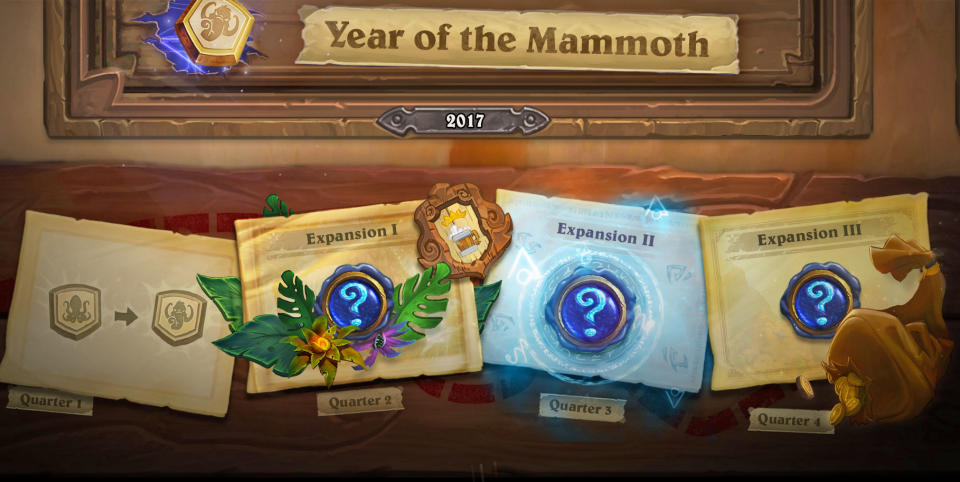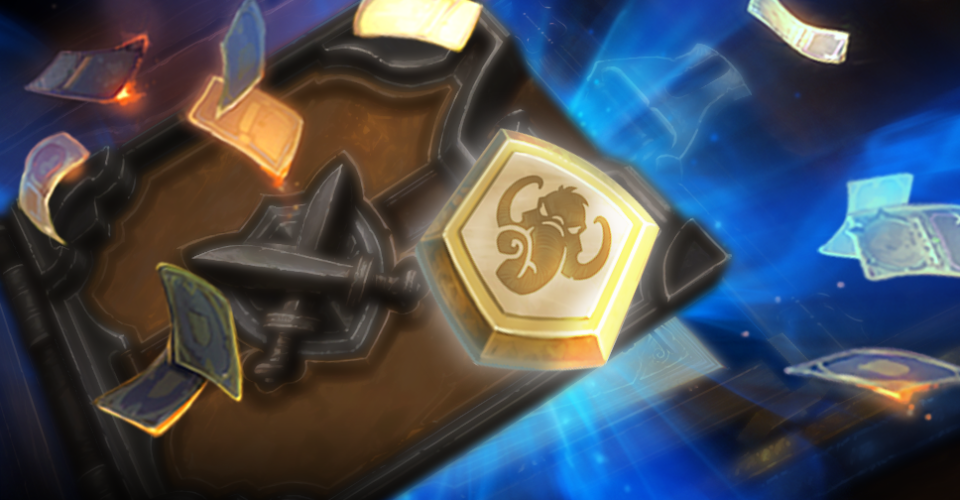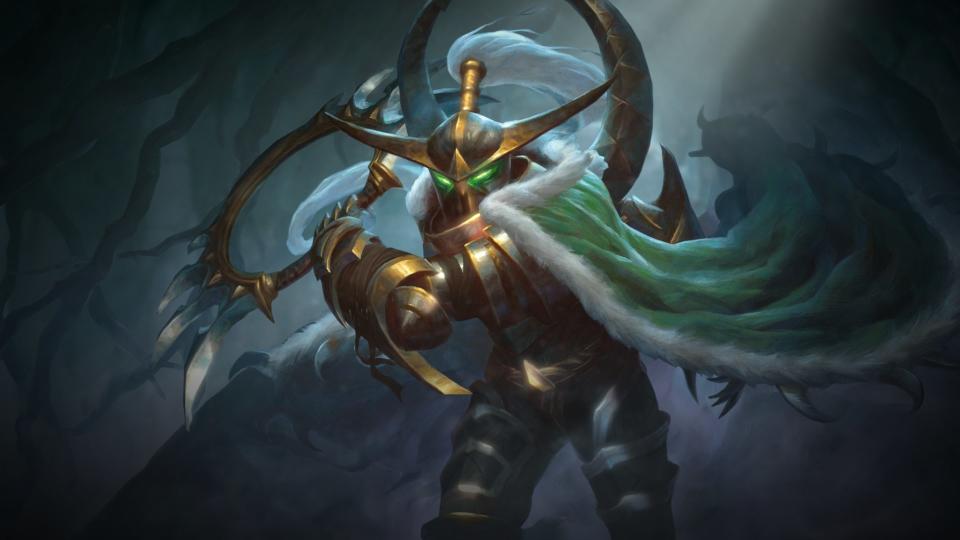It will cost $670 to get 90 percent of 2017's 'Hearthstone' cards
If you’re just using real money, expect to pay over $200 more than last year.

Since it launched in 2014, Blizzard's free-to-play digital card game Hearthstone has dominated its niche. To keep gameplay fresh, the studio has alternated new content additions between Adventures, which guarantees some cards for a $20 flat fee, and larger expansion sets that dole out cards in randomized packs bought with in-game gold or real-world currency. Last week, the studio announced it will forgo any Adventure releases in 2017, instead launching three of the latter full-size content blocks for 2017. While this means a record amount of cards will be added, it will be harder -- and more expensive -- to get all of them.
How pricey does that make Hearthstone now? If players only spent real-world money buying enough packs to get 90 percent of this year's content, it would cost them about $670 up front.
That's the number Redditor FliccC arrived at in a post they published shortly after Blizzard's announcement, a total that is significantly higher than the $440 or so it cost to buy the same percentage of last year's content. While casual players can coast along, picking up a pack every so often with in-game currency awarded for daily playing, competitive online and tournament play relies on high-performing decks filled with many of the latest cards. And if you imagine yourself a Hearthstone innovator, the only way to workshop new strategies is to personally try out novel combinations in live matches against real opponents who are also packing the newest and coolest toys.
This level of ranked online and tournament competition is kind of like Hearthstone's end-game content, the challenge lying beyond the casual-mode bunny slopes. As with any statistics-driven scenario, science points to an arbitrary threshold before pouring more money into the card-pack slot machine gives diminishing returns (e.g., duplicates). According to FliccC's calculations based on this BlizzPro guide, purchasing 200 packs should net a player around 90 percent of any given 130-plus card expansion set. Despite strategically choosing the pre-order deal and bulk buys, this comes out to $223 when shopping straight from the studio's online store. Even the slick trick of using Amazon Coins for cheaper packs nets a maximum discount of 25 percent off.

While players faced this pricey pack roulette for two of last year's content releases, they caught a break with last August's Adventure, One Night In Kharazan, which provided every card in its small set for $20. In its announcement, Blizzard, which has not yet responded to a request for comment on this story, committed to adding Adventure-style single-player content to the second of this year's expansions, which will reward free packs. But as far as we know, it won't also offer cheap packages that guarantee cards. Basically, then, if you're paying up front and want most of this year's Hearthstone content, for completionist satisfaction or to play competitively, you'll probably have to spend a little over $200 more than you did last year.
Frankly, that's kind of nuts. That kind of money spent on a single expansion could buy 13 more months on World of Warcraft or three more $60 major studio games. Heck, purchasing most of all three expansions at that $670 figure could sponsor your 20-person WoW raid group for two months.
Not everyone buys the whole set up front, of course, and most don't spend much more than a WoW subscriber. Redditor FliccC has spent $800 since the game launched, or about $20 per month. That's not uncommon: A SuperData report noted that digital collectible card game (CCG) players spend an average of $34.22 per month on those titles. Given that Hearthstone earned four times as much as its next competitor, it will likely take the lion's share of the $1.4 billion digital CCGs are expected to rake in this year.
There are irregular straw polls on the r/Hearthstone subreddit asking how much total money users put into the game, and one last April found that 24 percent of the more than 25,000 vote sample size hadn't spent a dime. There will always be the few whales in the ecosystem paying thousands of dollars, like in mobile gaming. But a combined 32 percent -- 8,000 -- had dropped between $100 and $400 over Hearthstone's lifetime. That percentage was almost identical in the latest poll, released two months ago.

The question is whether you need all of those cards. Having every option on hand is obviously helpful when tinkering, but the quality of cards in any given set follows a bell curve, with useless junk at the bottom and powerful cards at the top. FliccC, a player since the game was in beta, pointed out that only a small selection of the 901 total cards in Standard format are used at the competitive level.
"If you look at the decks that are competitively played on ladder and in tournaments, the number of viable cards is relatively small. Simply due to the fact that there are currently some cards which are so strong, that if you didn't include them in your deck, your deck would be considerably worse," FliccC told Engadget. "In the current meta, people are building decks around mainly two very strong cards: Kazakus and Patches, the Pirate. This leads to many different decks, but since they share a lot of the same cards, the overall competitively viable card pool is rather small."
For the cash-strapped, Blizzard is a merciful game custodian, and there are mechanisms in Hearthstone to help players chisel away at new content's sticker price. Completing daily quests and wins nets them, on average, enough in-game gold to buy about 1.5 packs per day. But they'll still deal with the random results of opening packs, which could hand out dominating legendary-rarity cards or poor-quality "pack fillers." In many ways, Adventures leveled the playing field, doling out the same cards to everyone who paid its entry fee, including a handful that still make it into top-tier decks today.
That's where Hearthstone's free-to-play tier will veer even further from competitive viability in 2017. There's always been a divide between free-to-play casuals and players committed enough to drop cash on the game, but ditching Adventures also makes the game more expensive, period. Those small sets were not only fun single-player experiences but also affordable and cost-efficient. The most recent, One Night In Kharazan, cost $0.40 per card, while a standard expansion (not considering freebies given out by Blizzard) costs about $1.90 per, according to FliccC's numbers.
You might notice the former rate is far lower, which is what happens when comparing flat-fee sets giving guaranteed cards with the randomness of the pack roulette. The latter ends up providing players with many duplicates that can be refunded via "disenchanting" for a miserly amount of dust, a secondary resource that can be spent to make any card at a cost that ratchets up based on rarity. Obviously, more extra cards means more dust to go around, making it easier for higher-paying players to afford crafting missing cards. This largesse lets them build out the highest-rated decks listed online, which all cost at least 3,000 dust to make from scratch. A single legendary-rarity card like the game's current scourge Patches, The Pirate costs 1,600 dust to craft.
There are some unknowns that affect whether paying players will get a bigger competitive edge over their free-to-play peers in 2017, but the most significant x factor is Blizzard's generosity. While it only gave out six free boosters as quest rewards when the latest expansion, Mean Streets of Gadgetzan, launched, the studio promised daily giveaways of gold, dust and free packs leading up to the first new content release in 2017. To their credit, Blizzard is fully aware of the uncertainty surrounding free-to-play viability in a three-expansion year, and the Hearthstone team hopes that ramping up the amount of free packs given to players will make up the difference (skip to 27:18):
If you're good and scrappy, you can get pretty far on free stuff: Popular Hearthstone streamer Trump (mayor of value town, not president of the US) infamously almost made it to Legendary rank with a free-to-play account after 2016's first expansion. If we're lucky, the fountain of gratis goods coming with the year's inaugural set will soothe the growing gap between the game's low-spending and high-paying players.
